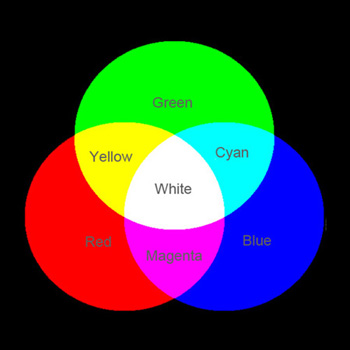Why are RGB LED strip lights called color changing LED strip lights?In order to generate luminous colors, LED controllers are required to operate color changing RGB LED strips. These controllers, set between LED power supply and RGB LED strips, take over the color management for RGB color changing LED strips. An RGB LED controller works basically like a 3-way dimmer, which regulates the brightness of the three basic colors through three channels. The three basic color channels are dimmed to different levels of brightness, whereby the relative brightness of the individual channels to each other, not the absolute brightness, is decisive for the cumulative luminous color. The sum of the intensity of the three individual colors results in many light colors. Exactly how many? The answer is that it can produce 16,777,216 (256x256x256) colors.
Additive color system of RGB LED strip lights The best examples of additive color system can be found on computer monitors or on TV screens. With a strong magnifying glass, you'll see that each pixel consists of red, green, and blue sub-pixels. By changing the brightness of these sub-pixels, you can create light of any color. The figure below shows the mixing scheme for the additive system.  The additive color mixing system is like this: Red + Green = Yellow, Red + Blue = Magenta, Blue + Green = Cyan, Red + Blue + Green = White. The more colors are added and mixed, the brighter the resulting color. Because the relative brightness is critical, RGB LED strips can not only produce the desired color, but also can adjust its overall brightness. This can be simply understood like it is as for flashlights. It is different brightness for one flashlight, two flashlights, and three flashlights. The more flashlights there are, the higher the brightness. In contrast, subtractive color mixing system is on the opposite. The more colors are added to the mixture, the darker the color produced. For example, painting is a subtractive color mixing system because the color of the painting is the result of light reflection, not light-emitting. Most color changing LED strip lights use 5050 LEDsMost of the color changing LED strip lights use 5050 LEDs because of their strong performance as colored LEDs. The 5050 RGB LED has red, green, and blue color chips enclosed in the same LED casing, 5050 RGBW LED has one more white chip, and 5050 RGBCCT LED has two more white chips. 5050 LED's size is 5.0x5.0x1.6mm. 5050 LED's brace bracket is thick and the LED is physically sturdy. Because of its great color change performance, it has been widely used in multi color changing LED light strips. How do RGB color changing LED strip lights achieve color gradients?As mentioned earlier, RGB LED strip lights must work together with the RGB LED controller. However, in contrast to conventional dimmers, in addition to the basic ability to mix and produce different colors, the RGB controller has the advanced ability to control the dimension of time for the color change, affecting the length of time between color change sequences. The control of temporal dimension allows RGB LED strip light to show a color gradient over time. Since most RGB LED controllers have the ability to control the temporal dimension of color changing, the multi color LED strips can produce dynamic color gradients as well as adjust the speed of the color gradient. |

